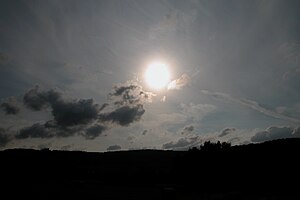Difference between revisions of "User:Cam66"
| (5 intermediate revisions by the same user not shown) | |||
| Line 1: | Line 1: | ||
| − | [[File: | + | [[File:chicken.jpg|thumb|120px]] |
==A Little Bit About Me== | ==A Little Bit About Me== | ||
| Line 34: | Line 34: | ||
==Grand Challenge== | ==Grand Challenge== | ||
| + | |||
| + | [[File:sun.jpg|thumb|Nuclear fusion occurs naturally in stars like the Sun.]] | ||
| + | |||
| + | [http://fusionforenergy.europa.eu/understandingfusion/ What is Fusion?], European Union’s Joint Undertaking for ITER and the Development of Fusion Energy, 2011, September 22, 2011 (Providing Energy from Nuclear Fusion) | ||
| + | |||
| + | Nuclear fusion is the opposite of nuclear fission. Instead of breaking apart heavy atoms like Uranium or Plutonium for | ||
| + | immense amount of energy (see: Nuclear Warfare), fusion forces together hydrogen atoms to create helium. The advantages of fusion are never-ending. There are no radioactive waste products that result from typical nuclear energy, and there is a practically unlimited source of fuel. Once engineers are able to conquer the realm of nuclear fusion, energy will be near free. The problems scientists currently face are ways to create both the pressures and temperatures of the sun, while still getting out a positive net product of energy. Currently, while it may be possible to produce fusion, it is incredibly impractical, due to the massive amounts of energy required. | ||
| + | |||
| + | ==MatLab Demonstration== | ||
| + | |||
| + | My favorite MatLab demonstration would have to be anything to do with the graphing. Most specifically, the Earth Topography feature seems fascinating. It must be esoterically useful, because it is its own function. It allows a user to create a map of the world, both in 2D and 3D, that can use altitude inputs to create a topographical map. The feature even includes latitude and longitude markings. | ||
Latest revision as of 23:32, 22 September 2011
Contents
A Little Bit About Me
What's there to know? I like chickens. A lot. A lot a lot. I own six. I come from the YAY AREA, and if you say "hella" and know what thizzing is, you are now my friend. In my spare time, I peruse Wikipedia articles (how apropos), caper about with the trombone, and splash around competitively in pools.
Oh! And I went to Carlmont High School! Look it up. C-MONT, YOU KNOW!
- In other news, I just read a Snapple Bottle Cap. It told me that the infinity sign is called a "lemniscate." Who woulda thunk?
How to Say the Name
My name is Cameron Mazza. That's Cameron. Cameron. CAM-er-uhn. Good luck screwing that up! kæm'ərin
Next. Mazza. It's MAH-zuh. Not MӐZ-zuh. Not may-ZAH. mäz'zuh And that's all you need to know!
My Favorite Websites
Wikipedia (Now I'm just sucking up)
Urban Dictionary (See Thizz and Hyphy)
Facebook (Teenagers gonna be teenagers)
Pandora (I do NOT spend money)
FML (aka what I do instead of EGR Labs; you didn't hear that Dr. G)
No Shame (you know you love me)
Grand Challenge
What is Fusion?, European Union’s Joint Undertaking for ITER and the Development of Fusion Energy, 2011, September 22, 2011 (Providing Energy from Nuclear Fusion)
Nuclear fusion is the opposite of nuclear fission. Instead of breaking apart heavy atoms like Uranium or Plutonium for immense amount of energy (see: Nuclear Warfare), fusion forces together hydrogen atoms to create helium. The advantages of fusion are never-ending. There are no radioactive waste products that result from typical nuclear energy, and there is a practically unlimited source of fuel. Once engineers are able to conquer the realm of nuclear fusion, energy will be near free. The problems scientists currently face are ways to create both the pressures and temperatures of the sun, while still getting out a positive net product of energy. Currently, while it may be possible to produce fusion, it is incredibly impractical, due to the massive amounts of energy required.
MatLab Demonstration
My favorite MatLab demonstration would have to be anything to do with the graphing. Most specifically, the Earth Topography feature seems fascinating. It must be esoterically useful, because it is its own function. It allows a user to create a map of the world, both in 2D and 3D, that can use altitude inputs to create a topographical map. The feature even includes latitude and longitude markings.

